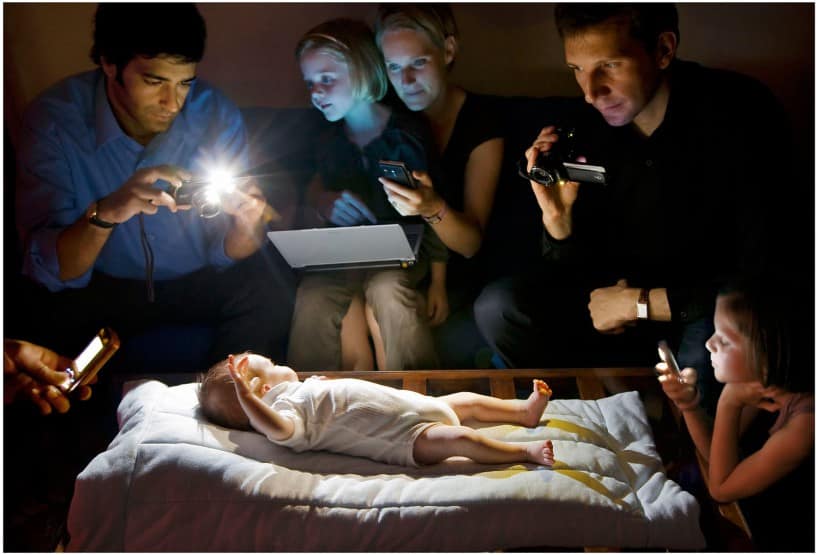
Tracking yourself – lifestyle hype or helpful research tool?
On a recent weekend I visited the Noorderlicht Photo Festival at the Old Sugar Factory. I was particularly struck by the Data Rush exhibit, where I saw photos on internet addiction running rampant in China, on the extensive use of surveillance cameras in England, and on people logging their lives using apps built for tracking various psychological variables, such as sleep and mood.
After seeing the first two series I felt angry and upset. How can we let children spend days on end on a computer without eating or sleeping, where some even die as a consequence? Why do we allow ourselves to be videotaped 24/7 as if we are all criminals-in-waiting? But then I saw the third series, by Travis Hodges, and it made me reflect on one of my research interests.
I like to use a method known as ecological momentary assessment (EMA, though other terms are used as well) for studying how people interact with others in their everyday lives. EMA is more broadly used to sample psychological (and biological) variables from daily life, and usually involves recording how you felt, behaved, etc., multiple times a day for several days.
In two recent reviews (Bos, Schoevers, & aan het Rot, 2015; Bosman, Jung, Miloserdov, Schoevers, & aan het Rot, 2016) my co-authors and I highlighted the usefulness of EMA and related methods in clinical settings. During her second Research Master year, Fionneke Bos conducted a literature study on the use of EMA in psychopharmacology research and practice. We developed this literature study into a systematic review, which was recently published in European Neuropsychopharmacology. The review shows that EMA may allow researchers and clinicians to track patients during different phases of pharmacological treatment: before treatment to predict outcome, during treatment to examine the effects of treatment on symptoms and different aspects of daily-life experience, and after treatment to detect vulnerability for relapse. Moreover, EMA can potentially help determine how long and in what contexts medications are effective.
Renske Bosman, who graduated from the BCN Research Master, and Sophie Jung, who completed her Bachelor degree of Psychology in Groningen, conducted the second systematic review after a literature study by Kristina Miloserdov, another BCN graduate. Their effort was recently published in the Journal of Affective Disorders. In this review we focused on Premenstrual Dysphoric Disorder (PMDD), which according to the DSM can only be diagnosed after patients provide at least two consecutive months of daily symptom ratings, i.e. complete a diary for this time. EMA is essentially a more advanced form of diary keeping. To date no EMA studies of PMDD have been conducted, but in our review we argued that EMA should be used to study PMDD; there are indications that premenstrual symptoms are not stable throughout the day, and so by asking about them at the end of the day only (as is typically done in diary studies) there may be an over- or under-reporting of symptoms.
EMA studies in clinical psychopharmacology and diary studies in women with PMDD have rarely focused on the effects of pharmacological treatment and the menstrual cycle on how people interact with others. I hope to focus on the former in an upcoming project for which I submitted a grant proposal last week, while results from a pilot study on the latter were recently submitted for publication. While these pilot data were obtained from 9 women with self-reported premenstrual syndrome (PMS), a mild version of PMDD, in another recent study I asked more than 120 first-year Psychology students to report on their social interactions for two weeks. The data of this study remain to be analyzed (Minita Franzen will be doing this in the upcoming 9 months or so) but are relevant to this blog post because study participants use their personal smartphones to record how they felt and behaved during their interactions with others.
This is the study I thought of when I was at the Data Rush exhibit. Travis Hodges reminded me of the fact that while I mostly view EMA as a helpful research tool, I may be riding on the wave of recent lifestyle hype. So far, I haven’t offered study participants any feedback on their data, the way the apps mentioned by Travis Hodges do. However, merely filling out the social interaction questionnaires (the average number was 65 in a previous study that used paper forms; aan het Rot, Moskowitz, & de Jong, 2015) can make people more aware of how they come across and how they see and react to the people they interact with. I decided that in a future study I will ask participants more qualitative details about their experiences with the EMA method. I usually ask if it interferes with their social interactions, but I do not ask whether they enjoy logging their social lives and whether it feels as an intrusion of privacy. I’m curious to find out.
Relevant Links and References
aan het Rot, M., Moskowitz, D. S., & de Jong, P. J. (2015). Intrapersonal and interpersonal concomitants of facial blushing during everyday social encounters. PLoS ONE, 10(2), e0118243. doi: 10.1371/journal.pone.0118243
Bos, F. M., Schoevers, R. A., & aan het Rot, M. (2015). Experience sampling and ecological momentary assessment studies in clinical psychopharmacology: a systematic review. European Neuropsychopharmacology, in press. doi: 10.1016/j.euroneuro.2015.08.008
Bosman, R. C., Jung, S. E., Miloserdov, K., Schoevers, R. A., & aan het Rot, M. (2016). Daily symptom ratings for studying premenstrual dysphoric disorder: A review. Journal of Affective Disorders, 189, 43-53. doi: 10.1016/j.jad.2015.08.063



